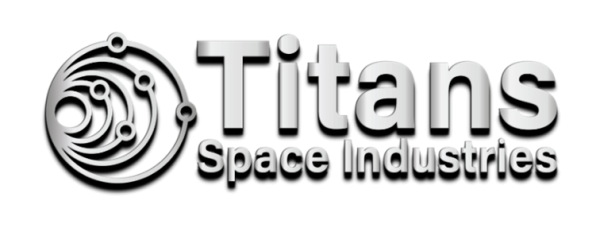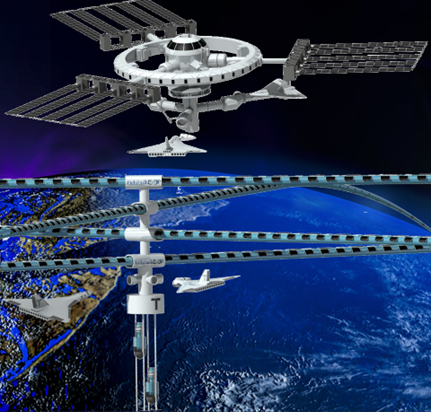
A startup founded by technology veterans plans to build and operate the initial phases of large scale orbital infrastructure, including a 100 kilometer tall Space Elevator and Ultra-Low Earth Orbital Ring, within the next ten years.
Titans Space Industries (TSI), part of Titans Universe, the world’s largest startup, has recently unveiled its plans to build orbital infrastructure, including a space elevator and orbital ring, at 100 kilometers altitude. Rockets are currently the only way to send humans to space, and TSI’s orbital infrastructure will offer safe, quick, and vastly more efficient alternatives to rocket launch vehicles – allowing the commercialization of space, and affordable space travel.

Background
In the more than fifty years since the first moon landings, rocket technology has greatly improved.
We have a million-fold better computing power, near-full automation abilities, and access to better materials and technologies, including robotics and modeling.
In recent years, Elon Musk’s SpaceX and Jeff Bezos’ Blue Origin have proven reusability of rocket boosters, and things will only get better from here. Musk even hopes to send armadas of Starships to Mars – with humans.
Nevertheless, while rockets and relevant technologies and materials will indeed improve, rocket systems are, as one researcher stated, “the most hazardous method of transportation ever invented.”
Despite the many rocket launches today, only twenty-four people have ever reached escape velocity: the crews of the Apollo missions to the Moon. There was no real reason to do so again for the last 50+ years, and there was no equivalent powerful rocket launch vehicle system like we had with the Saturn V that launched the Apollo missions (1968-1972). NASA’s SLS rocket is the first rocket system capable of taking people to the Moon; it’s tests are underway.
TSI’s Proposition
The full benefit and full scope of opportunities of space travel and space commerce cannot be achieved with rockets because they are too limited in scope and size, and too inefficient.
What TSI is proposing is nothing short of a true paradigm shift that will make rockets look like a horse and buggy compared to an ultra-modern jumbo-jet.
“We’re going to do with the space industry what we did with the telecom industry 22 years ago when we pioneered fiber to the home for the masses. The space industry will never be the same again. What is normal today, like rockets, will become less of an obvious choice for space travel, and what’s unique or rare today, like becoming an astronaut, will be a far more realistic option for millions of people,” said TSI’s Principal Founder & CEO, Neal Lachman, a 27-year telecom and tech veteran who also funded the first satellite broadband pilot in 1999.
Summary of previous space infrastructure proposals
“Another one of my projects was to construct a ring around the equator which would, of course, float freely and could be arrested in its spinning motion by reactionary forces, thus enabling travel at a rate of about one thousand miles an hour, impracticable by rail.”
The quote is from Nikola Tesla’s 1919 collection of autobiographical essays in which he distills the entire essence of the orbital ring concept.
TSI calls its orbital rings OrbitalLoop Systems. The company has invested thousands of hours in the research and planning of its OrbitalLoop Systems, which are based on the “orbital ring” and space elevator concepts, loved by space enthusiasts all over the world. As such, TSI is capitalizing on tens of thousands of hours invested by scientists, engineers, physicist and enthusiasts.
Dr. Paul Birch wrote a trilogy of scientific papers, outlining in detail how to build orbital rings, starting with a small, initial part, and then expand the infrastructure in phases. Dr. Keith Lofstrom built upon those papers to come up with his eponymous Lofstrom Loop, and inventors like Dr. Quine, Dr. Roberts, and Dr. Yunitsky came up with their own novel versions of space infrastructure. Physicists like Dave Nelson offered their own proposals how to kickstart the construction of orbital rings. In short, plans for space infrastructure have been presented by many people and organizations for decades, including the International Space Elevator Consortium.
Futurists like Isaac Arthur expanded on the orbital rings concept with their own vision. Researchers Andrew Meulenberg and Karthik Balaji offered their own proposal. The wheel has already been invented.
TSI benefits from decades of research, technological progress, more relevant business models and applications, and the company’s internal strengths in terms of financial, technological, and business engineering, and most importantly access to capital.
Orbital Infrastructure: Characteristics and Benefits
In the coming years, TSI will build space elevators, but only 100 kilometers (62 miles) tall, not 40,000 kilometers as others are proposing, and connect them to the OrbitalLoop. TSI will build terawatts worth of clean energy farms, but on the OrbitalLoop systems, not 40,000 kilometers away in space. As such, while TSI’s solutions sound like science fiction to the uninformed person, they are rooted in more realistic terms than space projects proposed by others (including governments), and realizable within the next ten to fifteen years.
TSI’s OrbitalLoop Systems, when fully operational, will enable transport and travel in the broadest sense of the words; it’s perfect for quick, safe, and efficient transport of cargo, goods, and materials, as well as distribution of critical infrastructure (fiber optic cables, electricity cables, water and fuel pipes), and delivering broadband internet connectivity and backhaul (Free Space Optics, wireless etc.).
The OrbitalLoop System will also function as an international orbital railroad that allows transportation of people and cargo across oceans within a few hours rather than 14+ hours on an airplane or a week in a ship.
Similar OrbitalLoop systems will be built in the Moon’s orbit from 2030 onward.
Because the OrbitalLoop also functions as the launch track for spaceships, these vehicles don’t need fuel for take-off. The only fuel needed on board is for some additional acceleration while in space, and for turnover/deceleration at the point of destination. Once arrived at the destination OrbitalLoop, the spaceship is refueled, and ready for return to the OrbitalLoop it departed from, or onto another OrbitalLoop.
An OrbitalLoop system, whether in Earth’s orbit or the Moon’s orbit, consists of the following elements:
1. The ring/loop itself with structures and platforms on it;
2. A magnetic levitation track (for special pods and spaceships) across the entire ring/loop; and
3. Elevators anchored to the OrbitalLoop to and from the surface to transfer people and cargo.
Earth OrbitalLoop Systems specs:
• Four or more rings: the first will be equatorial, the second will be polar
• Approximately 40,000 kilometers long (Earth’s circumference).
• Situated at 100 kilometer altitude
• Normal gravity
Earth OrbitalLoop Systems benefits:
• Launching spaceships with humans and cargo to the Lunar OrbitalLoop
• Launching spacecraft with cargo to the Lunar OrbitalLoop
• Space Solar Power generation
• Ultra-fast international city-to-city transportation of humans and cargo
• Living and working space for 100,000s of people
• Space Tourism
• Numerous elevators to and from Earth’s surface (safe, quick, and efficient transportation)
Low-cost transportation of cargo to and from Earth and the Moon will make large scale space mining and space manufacturing feasible and highly profitable.
The OrbitalLoop as a space launch system removes the risks of rocket explosions and loss of precious human lives and costly cargo during take-off, re-entry, and landing entirely from the equation.
TSI believes that the future of space travel will unfold with OrbitalLoop systems instead of rocket launch systems, and that the use of rockets will be very limited once OrbitalLoop systems become operational.
About Titans Universe
Titans Universe projects include Titans Space Industries, Titans Earth Industries, Titans World, Titania Oceana, and Titania Lunar. For the last few years, Titans Universe has been a project under stealth of NSL & Co. LLC, a Private Equity firm, Mergers & Acquisitions Advisory and Business Consulting group.
The Titans Universe team consists of a group of partners with a combined 450 years of experience and includes a former multi-billion dollar fund manager, a Hall-of-Fame NBA basketball legend, a next-gen telecoms pioneer, a multi-billion dollar business strategist, and a former CFO of a Formula One racing team. The team has worked more than a combined 200 years together on numerous projects.
Titans Universe is currently in the process of structuring all of its projects as separate legal entities in Europe, North America, South America, and Asia, separate from NSL & Co. LLC.
For further information:
- Titans Founding Team (link)
- Critical Analysis of Rocket Launch Systems, and Predictions for Spaceplanes, Spaceships, and Orbital Rings; Original analysis by TSI, July 22, 2022
- All Titans Space Industries projects (link)
- High-Quality pictures: OrbitalLoop, Space Elevator, Space Station (OrbitalPort), Spaceplanes, Space Diving, etc.
Videos:
- OrbitalLoop
- Titans Space Society
- Space Diving
- Titans Spaceplanes
- Titans OrbitalPort
For an up-to-date list, visit the playlist.
Media Contact
Company Name: Titans Space Industries
Contact Person: Neal S. Lachman, Principal Founder & CEO
Email: Send Email
Country: United States
Website: https://www.titanssi.com/